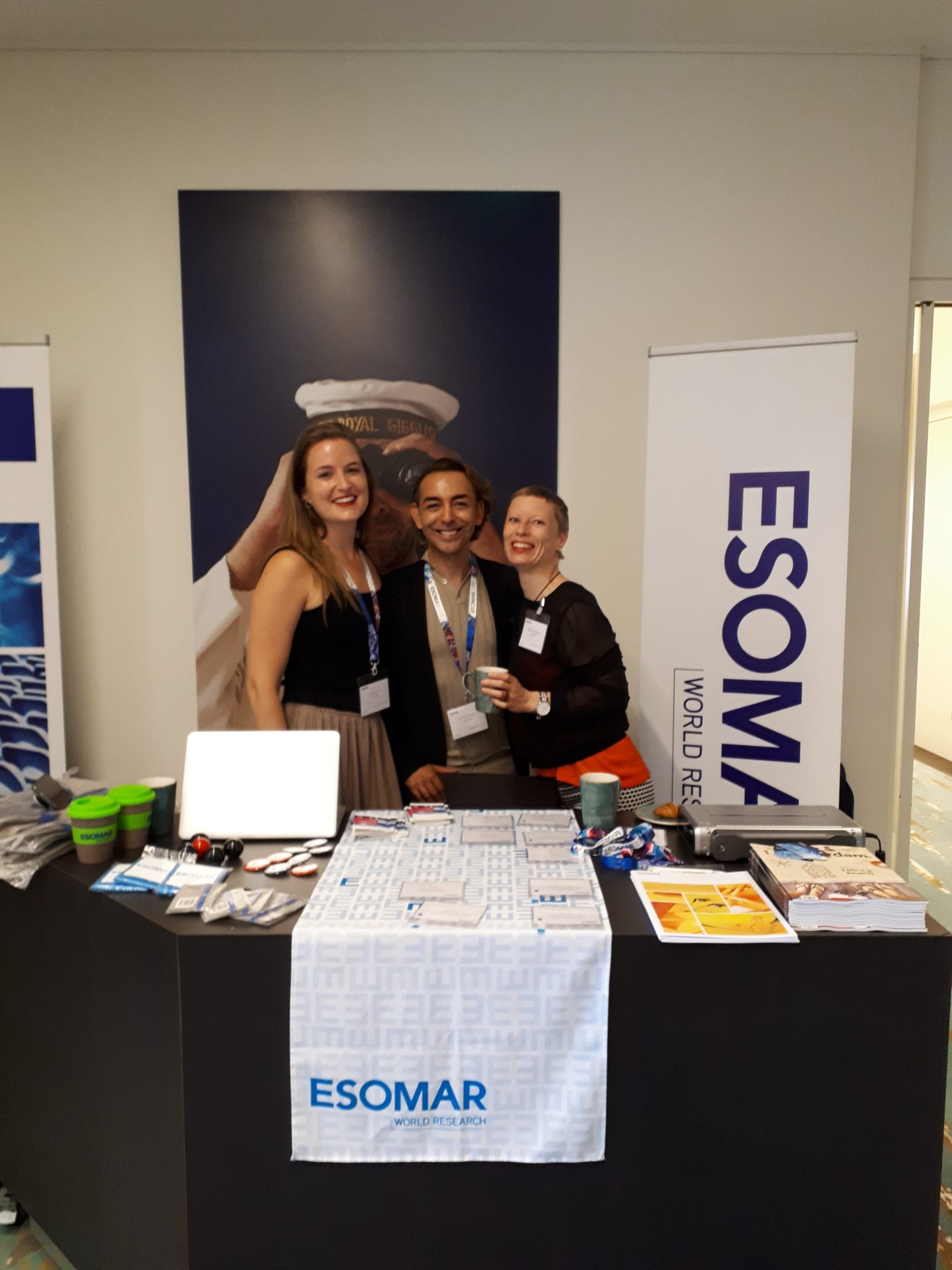by Irene Kowalenko
Last week, I had the chance to attend ESOMAR’s Shopping Experience Seminar in beautiful and sunny Amsterdam to exchange with other passionate Insights professionals on the changes the retail sector is undergoing and how we can better address the challenges manufacturers, retailers, and shoppers are facing.
Perfectly matching the seminar’s focus on valuable experiences, ESOMAR’s team made sure everyone was warmly welcomed and set to get the best out of this event. Besides the friendly atmosphere, I was impressed by the participants’ diversity in terms of demographic, cultural, and professional backgrounds. It was also nice seeing all the curious eyes and sensing such highly collaborative spirit. No matter if newbie or veteran, everyone was approachable, open, and excited to learn from each other. And the program definitely lived up to our expectations providing us with sparkling ideas for our researcher hearts and minds and input for our projects.
While it is impossible to cover all learnings, here are some personal highlights.
In his lively opening remarks, Nick Bonney (deep blue) set the scene for our fruitful and interactive sessions. Though nowadays it seems more fashionable to talk about digital strategies, he reminded us of the critical role that brick and mortar plays in building stories for unique and tangible experiences as part of an integrated and seamless journey in harmony with digital touchpoints.
Following this, Grant Wither (ShopTing) invited us to reflect on what brings shoppers to specific stores when defining a store’s role and USP. To deliver shopper-led product and service innovations, retailers are well advised to start with understanding who their shoppers and prime prospects are. Thereby, it is critical to know which information they expect and need depending on their shopping mission to influence behaviors through relevant offers. “Relevance is the new currency” as Ludovic Depoortere (Haystack) afterwards captured.
I personally found Grant’s ideas and questions refreshing. He helped us taking different perspectives and made us wonder what we may not know, what cannot be measured and how it may
change shopping behavior. I value how he embraced curiosity motivating us to constantly ask why we observe what we observe and what we may miss out on by considering, for instance, macro trends. As many manufacturers and retailers struggle to use the right data, it was helpful to see his example of how loyalty data can grow acquisition and retention. And it was eye-opening and calling for action when he quantified the economic value of being consumer and shopper led.
Ludovic inspired us how retailers and manufacturers can connect with consumers through new technologies and joint business planning. He wowed us with his video on how VR and AR may change our daily lives – from consuming products to dating someone. Bringing cases from across industries, he took us on the journey of a “phygital consumer” that has moved from digital first to mobile first to AI first. We were fascinated when he showed us the innovative app by Lemonade as one example of AI’s potential to transform even services like insurances, generally known for their complexity rather than enjoyable experiences. When speaking about how contextual factors such as cultural and technological trends are changing shopping behavior, Ludovic’s entrepreneurial spirit and enthusiasm for creating unique experiences for consumers and shoppers was simply contagious.
Bart Vandenreijt (Carrefour) took us through how Carrefour Belgium implemented a complete omnichannel approach to design targeted marketing based on

data-driven insights. We learned from his experience that developing an algorithm and knowing its ROI “is the easy part”. I appreciated how he promoted being innovative but also reminded us to be pragmatic by outlining practical impediments of change management when it comes to changing processes, inventories, etc. Luckily, one does not always have to reinvent the wheel to drive sales. One of his examples proved that sometimes it can be smart to use a personalized mail campaign.
Keith Sleight (Unilever) quickly endeared himself to the audience through his great sense of humor when he engaged everyone to look through shoppers’ lenses and empathize with them. “Shopping was and is a chore. And omnichannel is making it even worse with online offering a limitless warehouse”. At the same time, he motivated us to move from answering questions to provoking thoughts to understand how shoppers behave depending on their missions and disposable money. While technology is evolving fast, humans don’t. Hence, we have to combine research techniques to leverage data-driven and human-centered insights and to enrich them with deep contextual understanding to simplify choices and seize growth opportunities. I liked his forward-looking view unpacking the potential to unlock growth.
Additional inspiration how to drive growth was offered by Lindsey Cowan (Nepa) who highlighted the importance of connecting the dots across channels and touchpoints to convert individual shoppers on their paths to purchase. She encouraged us to map out what triggers and influencers bring shoppers into a category within the web of touchpoints and what potential barriers might be for each channel. Likewise, we have to think about what it takes to increase mental availability and get on a shopping list in order to grow penetration. At the same time, we need to know when shoppers are “open to be influenced” to win them (back). Thereby, P2P insights should create financially validated actions for all areas of the business in awareness of their opportunity costs.
More inspirational ideas followed, when Zyed Jamoussi (UntieNots) shared with us the ingredients required to reinvent a win-win loyalty experience. Due to the latest innovation in prescriptive AI, CRM automation, and real-time technology, it is now possible to offer an individual loyalty experience for shoppers at scale. It is impressive how combining behavioral data allows to profile each shopper. His case study of a “loyalty challenge” app proved how leveraging gamification can help generate real-time interaction and engagement accounting for cognitive biases by looking at what people do to understand what they like.
Danielle Pinnington (ShopperCentric) described the challenges of measuring today’s shoppers, their mode, mission, environment, and mindsets. For our research to reflect evolving shopping habits, we can use smart tech and combine explicit and implicit measures to fully understand why shoppers do what they do. Which reminded me of physics. Observation requires us to disturb the original state of the system. For instance, in quantum mechanics, to observe the position of an electron, we need to provide light, which in turn will change its original state, even though some of that supplied energy will be reflected back. Thus, we must investigate how research context may influence the insight, if respondents recall and recognize influences or when we need to capture the subconscious.
While Behavioral Economics sheds light on cognitive processes and biases, I will use her extensive overview of methods incl. their pros and cons as guidance when designing my next shopper research. I especially liked how she pointed out that insights should always aim for problem solving and have to drive conversion, profitability, and wins for brands, the category, and retailers. Hence, before translating business questions into a research question, we must define the action to be taken with that research to then choose the data that is going to answer the what and why.
To recap, while it seems like almost everything about shoppers and their experiences can be measured, it is up to us to distil what matters most to drive change and create value for brands, retailers, and shoppers. “Getting data and generating insights is easy, integrating it and changing organizations, processes, and behaviors is hard and sensitive” as Bart summarized it nicely. In other words, “impact is the name of the game” to paraphrase Tom de Ruyck (InSites Consulting), one of the biggest Insight Activation advocates in our industry. For those who are keen to learn more about how to turn insights into actions, I highly recommend reaching out to Tom who has a rich portfolio of examples.
Summing up, amid the deluge of information and data in today’s flurry shopping environment, we need to constantly be on the lookout for innovative ways to integrate the new sources of insights to guide decision making and, ultimately, drive growth. At the same time, insights – whether coming from human, augmented, or artificial intelligence – can only be powerful if couched in simple ways and activated pragmatically. Disruptive insights require gradual change to achieve sustainable impact. They can enable us to be vision-oriented but action driven.
Taking into account what I had learned from the previous market research conferences I attended all over Europe, my personal take away is: The MR industry is definitely well equipped with innovative tools and approaches as well as bright and creative people to understand where and how to unlock growth. Combining our left and right brains with powerful technologies, our opportunity lies in integrating the various sources of data and merging it with existing and new insights. Doing this with excellence while ensuring relevance, actionability, and feasibility, requires a link to the business needs along with a deep understanding of the organizational and cultural context in which we want to drive positive change and create maximum value.
Thank you to everyone who was part of this seminar for the huge value I got out of it, professionally and personally. Always curious to learn more, I cannot wait to see you again soon – maybe at ESOMAR’s Congress in Berlin in September?
Irene Kowalenko is a Consumer and Market Insights & Analytics Professional


